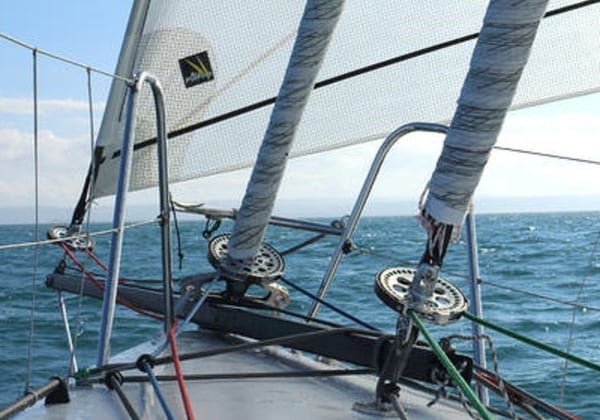
Have you got any idea what's the difference in design between a top-down or bottom-up torsional cable? Find out what makes a good torsional cable and the important differences between the two applications.
They might look the same but a top-down furling cable requires a fundamentally different specification to that of an equivalent length bottom-up cable. Top-down furling cables are more expensive and there may be a temptation to go for the cheaper, bottom-up option. But you do so at your peril ..... as failures can be expensive!
What makes a good torsional cable?
The secret to torsional performance is in the covers of the cable. A variety of techniques are used by different manufacturers but, in essence, the covers are designed to act like a torsional tube, around the core fibre. Torsion is a function of the force applied by the distance (r) from the axis of rotation, which for a cable is its centre.
Therefore, torsional force increases relative to the diameter of the cable. The trick with a good torsional cable is to maximise the torsional stiffness but still retain overall cable flexibility to allow it to be stuffed into the bag with the sail when not in use.
Bottom-up
Bottom-up cables are highly loaded to ensure good luff tension in your straight luffed code zero or staysail. Therefore, cable stiffness is a key performance parameter together with minimum diameter to reduce upwind drag. This is why PBO is the optimum core material for bottom-up furling cables on GP race boats, being the stiffest, lightest and smallest diameter soft composite fibre available on the market.
Good torsional performance is obviously also required, however, as the furl starts at the bottom of the sail, within a few turns the tack of the sail has rolled onto itself and the sail luff starts to assist in the transfer of torque up the cable. As the sail luff adds significant diameter to the cable, it actually contributes significantly to the effective torsion of the overall cable/sail furling system.
Top-down
Top-down cables used on loose luff, downwind sails, spend much of the time slack and should only be fully loaded during furling and unfurling. As the furl starts at the head, the torque has to be transferred from the drum, along the full length of the cable without any assistance from the sail. In addition, due to the larger sail area of gennakers, speed is a critical success factor for top-down furling. High torsional loads and high speed mean that torsional performance is THE most important cable characteristic for a top-down cable.
With relatively low working loads, the core fibre's only role is to be light and fat to provide diameter to support the cable covers which are doing all the work. This is why Dyneema® offers an excellent choice for the core of a top-down cable. It is one of the lightest and strongest fibres on the market which allows you to build diameter without a weight penalty. Gottifredi Maffioli goes one step further in the pursuit of building low-load, lightweight, large diameter top-down cables by using a hollow filament called Aircore at the centre of the cable, surrounded by Dyneema® and then the outer covers to deliver the torsion.
Summary
- Bottom-up cables need to be stiff, thin and light whilst still delivering reasonable torsion
- Top-down cables are all about torsional stiffness and need maximum diameter without adding too much weight.
If you have any questions about torsional cables, please feel free to email us at support@upffront.com, or click the link below to see our full range:




